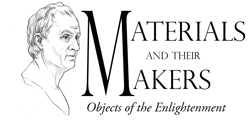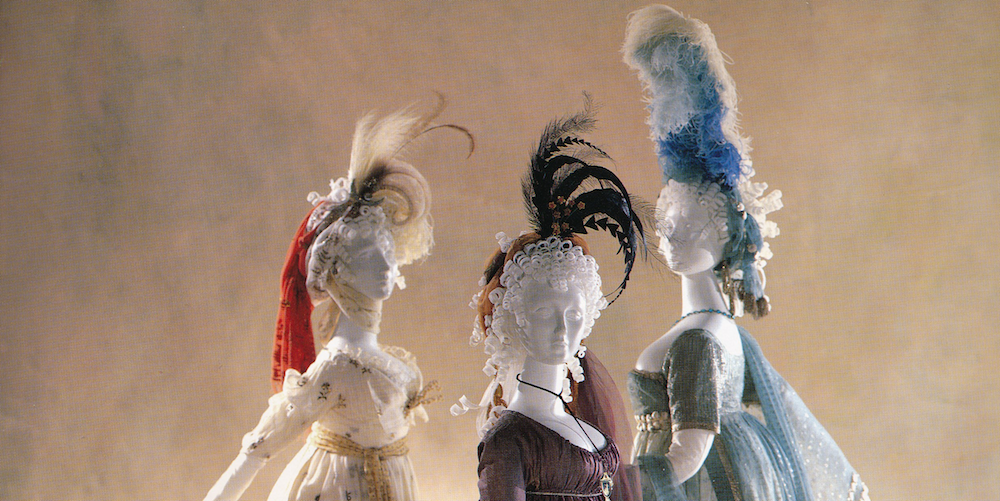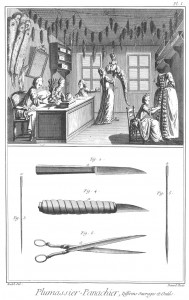
Encyclopédie plate of a feather workshop. Note the feathers hanging from the ceiling to dry, being cut and prepared by women on the left, and sewn onto outfits by woman on the right. The woman in the back is making a horse’s plume. Below are tools for cutting, curling, and sewing feathers
The feathers used in clothing decorations came from several types of birds, most commonly ostriches, herons, egrets, and peacocks, among others. Heron feathers were particularly rare and desirable. Different types of feathers, such as those coming from geese, swans, or ravens, would be used as quills. Craftspeople who made and sold feather decorations were called “plumassiers.” These workers added feather plumes to hats, trim to gowns, and even created head decorations for horses. Not only were feathers fashionable in garments, but they were also sometimes used on furniture.
Feathers were most commonly used as plumes in hats. Expensive hats combined lace, silk, feathers, and other decorations. Hats were priced based on the number of feathers used, and on the type of feather. Ostrich plumes were made of multiple feathers sewn together, and were very popular for hats. The addition of feathers to hats greatly increased the price of these goods. Plumassiers had to understand the pricing of feathers, and how to prepare them.
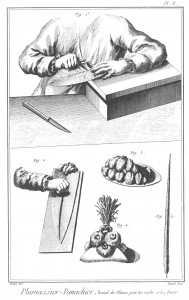
Enecylopédie plate of workers’ hands degreasing and curling ostrich feathers in preparation for plumes
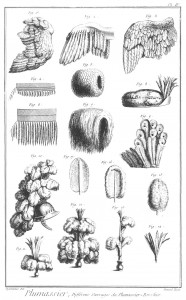
Encyclopédie plate showing examples on the left of how feathers could be stitched into fringes. Bottom images show arrangements of feathers into plumes
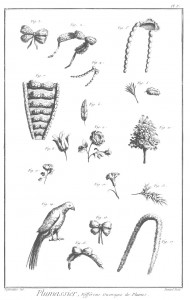
Encyclopédie plate showing examples of fine feather and flower decorations, including bows. The bottom left shows a bird from which tail feathers would be taken
The process of preparing feathers for adornment included degreasing them and hanging them to dry (as seen in the Encyclopédie plate of the workshop, above), cutting and curling them (as seen in the plate of workers’ hands, above), and sewing them together or to an outfit (as seen in the workshop plate). Sometimes workers rubbed feathers with glass to flatten them. In the plate depicting the feather workshop, Fig. 4a displays the curling knife. Fig.s 3a and 5a show the differently sized needles used to attach feathers to various surfaces. As we can tell from this plate, the workers were usually female.
For more information on feathers, please see:
Delpierre, Madeleine. Dress in France in the Eighteenth Century. Translated by Caroline Beamish. New Haven and London: Yale University Press, 1997.
Diderot, Denis, and Jean Le Rond d’Alembert. Encyclopédie Ou Dictionnaire Raisonné Des Sciences, Des Arts et Des Métiers. Geneve: J.L. Pellet; [etc.], 1778.
Starobinski, Jean, Philippe Duboy, Akiko Fukai, Jun I. Kanai, Toshio Horii, Janet Arnold, and Martin Kamer. Revolution in Fashion 1715-1815. Edited by Amy Handy. New York: Abbeville Press, 1989.
Image citations:
Diderot, Denis, and Jean Le Rond d’Alembert. Encyclopédie Ou Dictionnaire Raisonné Des Sciences, Des Arts et Des Métiers. Geneve: J.L. Pellet; [etc.], 1778.
Starobinski, Jean, Philippe Duboy, Akiko Fukai, Jun I. Kanai, Toshio Horii, Janet Arnold, and Martin Kamer. Revolution in Fashion 1715-1815. Edited by Amy Handy. New York: Abbeville Press, 1989.
